“The question is not why the addiction, but why the pain.”
— Dr. Gabor Maté, In the Realm of Hungry Ghosts
Addiction isn’t really about substances, not at its core. It’s not about bad choices, weak willpower, or moral failure. It’s about pain—and the desperate, resourceful ways people try to escape that pain when they are not offered safety, connection, or care.
When we view addiction through the lens of psychosocial disability and trauma, it stops being a standalone pathology. It begins to make sense as a survival strategy—an attempt to soothe unbearable emotional states, unmet attachment needs, or a nervous system that has never felt safe. As Dr. Maté writes, addiction is “a complex psychological, emotional, physiological, neurobiological and social phenomenon.” And at its root is pain.
Why the Pain?
Most people struggling with substance use are not trying to rebel. They are trying to regulate. To feel calm or connected—or nothing at all. Substances like alcohol, cannabis, methamphetamine, prescription medications, food, sex, or gambling often offer a fleeting moment of relief from internal chaos.
This is what Dr. Maté calls self-medication. When trauma, chronic stress, or emotional isolation are present, and when healthier forms of co-regulation are unavailable, people reach for what they can. And for a time, it works. The substance dulls the pain, slows the mind, softens the body, and brings temporary peace.
But over time, what once helped begins to hurt. The coping strategy becomes a trap. And people find themselves caught between two impossible truths: I can’t live like this, but I don’t know how else to cope.
Addiction as a Response to Trauma
Many people living with addiction have experienced emotional loss, abandonment, neglect, abuse, or instability. Sometimes the trauma is obvious. Other times, it is subtle—consistently unseen, misunderstood, or left alone with big emotions and no one to help hold them.
Trauma doesn’t need to be catastrophic. It only needs to overwhelm someone’s capacity to cope without support. Addiction often becomes a stand-in for the regulation, safety, and comfort that were never provided in childhood, or later taken away by violence, poverty, illness, or exclusion.
Seen this way, addiction isn’t the problem. It’s the solution someone has used to survive something deeper.
The Shame Trap
One of the most painful consequences of addiction isn’t just the substance itself—it’s the shame. People internalise society’s moral narratives: that addiction is a personal failure, a selfish act, a reflection of brokenness.
That shame is only magnified when someone is also living with neurodivergence or chronic pain. The world often whispers, or shouts: You’re too much. You’re not enough. You should be better by now. These explicit or implied messages keep people isolated, silent, and stuck.
We must reject these narratives. Addiction is not a character flaw. It is a coping strategy that made sense in a specific context. Recovery is not about punishment or control. It is about restoring connection to self, others, the body, and the truth of one’s lived experience.
A Nervous System Seeking Safety
The nervous system plays a central role in addiction. Many people with complex trauma, ADHD, or sensory processing differences experience chronic dysregulation—swinging between hyperarousal (panic, restlessness, agitation) and hypoarousal (numbness, dissociation, collapse).
Substances offer artificial regulation. Stimulants may help someone feel alive or focused, and depressants may ease anxiety or emotional overwhelm. But these substances often substitute co-regulation—the calming presence of another person or a safe environment where the body can finally relax.
In the absence of relational safety, substances become the next best thing—predictable, reliable, and comforting, even if harmful.
Healing as a Return to Connection
Recovery is not about abstinence alone. It’s about reconnection to the body, emotions, history, values, and community. And that healing cannot occur in environments rooted in shame or coercion. It requires compassion, structure, and psychological safety.
Dr. Maté reminds us that the question is not how to stop the addiction but rather how to support the person. What pain needs to be honoured? What story needs to be heard? What would this person need to feel safe enough to stay present?
Recovery may involve trauma-informed therapy, peer support, medication, creativity, spirituality, cultural reconnection, or simply time. It may include relapse. It may take years. But it always begins with one essential condition: being seen without judgment.
What We Miss When We Focus on the Substance
When we focus solely on the drug or behaviour, we miss the function of the addiction. We overlook the logic in it. We ignore the person inside the pain.
We miss the mother who drinks not to abandon her children, but to numb the grief of her own unmet needs.
We miss the teenager who smokes weed not to rebel, but to quiet the panic he doesn’t have words for.
We miss the person using meth not to harm others, but to feel a sense of power in a life that has felt powerless.
This doesn’t mean addiction is without real and serious consequences. But it does mean we must stop treating it as a moral issue—and begin treating it as a signal. A flare from a nervous system in distress. A cry for relief, not condemnation.
A New Paradigm of Care
When we understand addiction through this lens, our role shifts as clinicians, supporters, or community members. We stop trying to control or fix. We listen. We validate. We walk alongside.
We focus less on compliance and more on what hurts. We replace lectures with curiosity. We trade judgment for presence.
At Transition Life Care, we believe that every person—no matter what they’ve used, how many times they’ve relapsed, or how long they’ve struggled—deserves a safe space to heal. We do not define people by their pain. We support them in understanding it. We meet them where they are, not where we think they should be.
Because healing happens in relationships—and no one should have to carry their pain alone.




